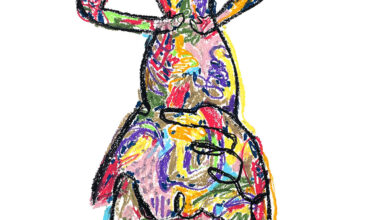
Zoot Magazine looks at the recently opened retrospective about Hussein Chalayan at Paris’ Musée des Arts Décoratifs.
Text by Anna Battista
There is currently a new exhibition on about Hussein Chalayn at Paris’ Musée des Arts Décoratifs, accompanied by a new book featuring over 200 colour illustration that examines the designer’s fashion and creative works. The volume, entitled Hussein Chalayn by Hussein Chalayan and published by Rizzoli, looks at the inspirations behind his works, his early beginnings and more recent collections.
The retrospective at Paris’ Musée des Arts Décoratifs is entitled instead “Récits de mode” (Fashion Narratives) and, while it doesn’t follow any chronological order, it includes designs from his most famous collections.
Born in Nicosia, Cyprus, Chalayan moved to England when he was 12 and, in 1993, he graduated from Central St Martins. His graduate collection, called ‘The Tangent Flows’ (1993) featured garments that explored the concepts of change and decay made with fabric he buried with iron fillings in a friend’s garden.

Further ideas were explored in later designs and Chalayan described as “monuments” to ideas three dresses from consecutive collections he did between 1999 and 2000. The first dress, from his ‘Geotropics’ (Spring/Summer 1999) collection, was made in resin and reminded of a chair that cocooned the model’s body, while symbolising the idea of the itinerant existence; the second “monument” was the airplane dress from the ‘Echoform’ (Autumn/Winter 1999-2000) collection that featured moving flaps activated by a switch operated by the model; the third outfit, part of the ‘Before Minus Now’ (S/S 2000) collection, was operated by a remote control that could lift the rigid flaps of the dress, revealing a froth of pink tulle underneath.

As the years passed, Chalayan’s collections turned into explorations of different themes, from nature to technology and architecture. Named British Designer of the Year twice (in 1999 and 2000) and awarded an MBE for contributions to fashion in 2006, Chalayan became well-known for taking his inspirations from ideas that are not usually associated with fashion, such as exile, alienation, power and powerlessness, nomadism, cultural displacement, transformation, DNA sequences, individuality and visions of the past in the future.

These complex and at times subversive themes were explored in the fashion show for his ‘Ventriloquy’ (S/S 2001) collection with its interplay of virtual and real narratives; in the garments from ‘Medea’ (S/S 2002) symbolising with their copious zips and ties an oppressive state of mind; in the ‘Genometrics’ (A/W 2005-06) collection with DNA chains inspiring the bulbous silhouettes of the outfits and in the more technological designs from Chalayan’s ‘One Hundred and Eleven’ (S/S 07) collection featuring dresses that morphed through different decades – from the early 1900s to 2007 – automatically transforming in shape and style thanks to a computer system designed by the London-based engineering and concept-creation firm 2D3D.

Among the best pieces exhibited at the Musée des Arts Décoratifs, there are the furniture-morphing dresses from his ‘After Words’ (A/W 2000-01) collection and the ‘Airborne’ laser dress made of Swarovski crystals and LED lights from his ‘Readings’ collection (S/S 08). The former were inspired by the news from Kosovo about people fleeing their houses in a rush during the war, but also by his own experiences as a Turkish Cypriot living abroad; the latter was a reference to the culture of sun worship and the cult of celebrity.

Yet there are also more recent designs showcased in this exhibition, including pieces from the S/S 09 collection, entitled ‘Inertia’ and inspired by the idea of speed and its consequences, from the S/S 2011 collection, that moved from Japanese poetry and theatre and from the more surreal aspects of the Japanese culture, one of them being the “Sakoku”, a term relating to the policy of isolation during the Tokugawa Period, when the country was closed to the outside world. The exhibition also features the remote controlled “Floating Dress” made in collaboration with Swarovski, part of the “Kaikoku” collection (A/W 2011), a term referencing this time Japan’s opening to the Western culture. The golden fibreglass and polyester resin “Floating Dress” can move around and release crystals symbolising pollen, used as a metaphor for the pollination of ideas and the quest for a new beginning.

The exhibition also allows visitors to get to know all the most important projects the designer has been involved in: since 2003, Chalayan also directed art projects, including the short films “Temporal Meditations”, “Place to Passage” and “Anaesthetics” and, in 2005, he represented Turkey at the 51st Venice Biennale with “Absent Presence”, featuring Tilda Swinton.

The retrospective at the Musée des Arts Décoratifs proves that Chalayan, who likes to define himself as “an ideas person”, rather than just a fashion designer, is truly a visionarily innovative designer, probably the one and only contemporary designer who managed to produce timeless experimental pieces bridging fashion and technology tackling themes such as the hybridisation of cultures, anatomy, genetic anthropology and the psychological and physical implications of imperial expansion, chronicling through his creations the dramatic changes and transformations society goes through.
Hussein Chalayan’s “Récits de mode” is at Paris’ Musée des Arts Décoratifs until 21st November 2011.















